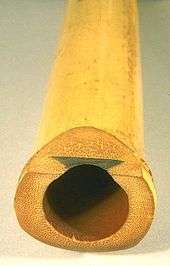End-blown flute
The end-blown flute (also called an edge-blown flute or rim-blown flute) is a woodwind instrument played by directing an airstream against the sharp edge of the upper end of a tube. Unlike a recorder or tin whistle, there is not a ducted flue voicing, also known as a fipple. Most rim-blown flutes are "oblique" flutes, being played at an angle to the body's vertical axis. A notched flute is an end-blown flute with a notch on the blowing surface. A lip-valley flute is a type of notched flute.

End-blown flutes are widespread in folk music and art music. In Europe, the Russians have the svirel, attested from at least the 11th century. In the Middle East and Mediterranean the ney is frequently used, constructed from reed. Depictions of early versions of the ney can be found in wall paintings in ancient Egyptian tombs, indicating that it is one of the oldest musical instruments in continuous use. Several ancient Persian artworks depict the use of the ney.
In Turkey the ney and kaval are both end-blown, although one type of Turkish kaval (dilli kaval) has a fipple. The Turkish ney plays a prominent role in classical Turkish music and Mevlevi (Sufi) music. The Arab nay and the Persian ney are similar to the Turkish ney. China has the xiao, Japan has the shakuhachi and Korea has the danso and tongso. People of the Andes play the quena, the Hopi and their predecessors the Anasazi of the American southwest have and had a flute similar to the ney. The washint is an East African flute. Panpipes are rim-blown in the same fashion with their lower ends stopped, bound together in a row or "raft".